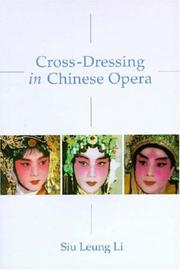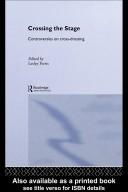| Listing 1 - 9 of 9 |
Sort by
|
Book
ISBN: 1282189727 9786612189722 1443803057 9781443803052 9781443802161 1443802166 Year: 2009 Publisher: Newcastle upon Tyne : Cambridge Scholars,
Abstract | Keywords | Export | Availability | Bookmark
 Loading...
Loading...Choose an application
- Reference Manager
- EndNote
- RefWorks (Direct export to RefWorks)
Masculinity is no longer a monolithic category, if ever it was. Long Live the King is a solid piece of scholarship that explores in depth the drag king phenomenon as well as key theoretical texts by feminist, postcolonial and cultural thinkers. Maite Escudero-Alías delves into drag king culture and highlights its relevance for the study of the relationship between gender, sex, race and sexuality. Introduced by a well-informed theoretical chapter that traces the roots of queer theory, Long Liv...
Male impersonators. --- Masculinity in popular culture. --- Queer theory. --- Gender identity --- Popular culture --- Cross-dressers (Male impersonators) --- Crossdressers (Male impersonators) --- Drag kings --- Impersonators, Male --- Impersonators of men --- Kings, Drag --- Actresses --- Persons --- Drag kings. --- Drag performance. --- Drag kinging (Performing arts) --- Drag queening (Performing arts) --- Performing arts --- Entertainers
Book
ISBN: 0252050169 9780252050169 9780252041518 9780252083150 0252041518 9780252041518 0252083156 9780252083150 Year: 2018 Publisher: Urbana Chicago Springfield
Abstract | Keywords | Export | Availability | Bookmark
 Loading...
Loading...Choose an application
- Reference Manager
- EndNote
- RefWorks (Direct export to RefWorks)
Female-to-male crossdressing became all the rage in the variety shows of nineteenth century America, and began as the domain of mature actresses who desired to extend their careers. These women engaged in the kinds of raucous comedy acts usually reserved for men. Over time, as younger women entered the specialty, the comedy became less pointed, and came to center on the celebration of male leisure and fashion. Gillian M. Rodger uses the development of male impersonation from 1820 to 1920 to illuminate the history of the variety show. Exploding notions of high- and lowbrow entertainment, Rodger looks at how both performers and forms consistently expanded upward toward respectable "and richer" audiences. At the same time, she illuminates a lost theatrical world where women made fun of middle class restrictions even as they bumped up against rules imposed in part by audiences. Onstage, the actresses' changing performance styles reflected gender construction in the working class and shifts in class affiliation by parts of the audiences. Rodger observes how restrictive standards of femininity increasingly bound male impersonators as new gender constructions allowed women greater access to public space while tolerating less independent behavior from them.
Male impersonators --- Revues --- Cross-dressers (Male impersonators) --- Crossdressers (Male impersonators) --- Drag kings --- Impersonators, Male --- Impersonators of men --- Kings, Drag --- Actresses --- Musical revues --- Musical revues, comedies, etc. --- Musical shows --- Revues (Musical) --- Shows, Musical --- Table entertainments --- Variety shows --- Vaudeville shows --- Dramatic music --- Minstrel music --- History --- History and criticism. --- Persons
Book
ISBN: 0803245688 1283948826 9780803245686 9781283948821 9780803240346 0803240341 1496210549 Year: 2013 Publisher: Lincoln University of Nebraska Press
Abstract | Keywords | Export | Availability | Bookmark
 Loading...
Loading...Choose an application
- Reference Manager
- EndNote
- RefWorks (Direct export to RefWorks)
Women anarchists --- Male impersonators --- Bisexual women --- Women sculptors --- Women authors, French --- Anarchist women --- Anarchists --- Cross-dressers (Male impersonators) --- Crossdressers (Male impersonators) --- Drag kings --- Impersonators, Male --- Impersonators of men --- Kings, Drag --- Actresses --- Female bisexuals --- Women bisexuals --- Women --- Sculptresses --- Sculptors --- Women artists --- French women authors --- Estoc, Gisele d', --- Persons --- Estoc, Gisèle d', --- Courbe, Marie Elise, --- Courbe, Marie Paule, --- Desbarres, Marie Paule Courbe --- Desbarres, Marie Paule Parent-, --- D'Estoc, Gisèle, --- Parent-Desbarres, Marie Paule,
Book
ISBN: 9780809335237 0809335239 0809335239 9780809335220 0809335220 Year: 2016 Publisher: Carbondale, [Illinois] : Southern Illinois University Press,
Abstract | Keywords | Export | Availability | Bookmark
 Loading...
Loading...Choose an application
- Reference Manager
- EndNote
- RefWorks (Direct export to RefWorks)
"She went by many names--Mary Ann Keith, Ann Williams, Lauretta Williams, and more--but history knows her best as Loreta Janeta Velasquez, a woman who claimed to have posed as a man to fight for the Confederacy. In Inventing Loreta Velasquez, acclaimed historian William C. Davis delves into the life of one of America's early celebrities, peeling back the myths she herself created to reveal a startling and even more implausible reality. This groundbreaking biography reveals a woman quite different from the public persona she promoted. In contrast to her bestselling memoir, The Woman in Battle, in which she claimed she was an emphatic Confederate patriot, Velazquez in fact never saw combat. Instead, during the war she manufactured bullets for the Union and convinced her Confederate husband to desert. After the Civil War ended, she wore many masks, masterminding ambitious confidence schemes worth millions, such as creating a phony mining company, conning North Carolina residents to back her financially in a fake immigration scheme, and attracting investors to build a railroad across western Mexico. With various husbands, Velasquez sought her fortune both in the American West and in the Klondike, though her endeavors cost one husband his life. She also became a social reformer advocating on behalf of better prison conditions, the Cuban revolt against Spain, and the plight of Cuban refugees. Further, Velasquez was one of the first women to foray into journalism and presidential politics. Always a sensational press favorite, throughout her life she displayed an uncanny ability to manipulate popular media and use her fame to her benefit in a way that foreshadows celebrities of our own time, including using her testimony in a Congressional inquiry about Civil War counterfeiting as a means of promoting her latest business ventures. So little has been known of Velasquez's real life that postmodern scholars have often glorified her as a 'woman warrior' and used her as an example in cross-gender issues and arguments concerning Hispanic nationalism. Davis firmly refutes these notions by bringing the historical Velasquez to the surface. Drawing on hundreds of sources including Velasquez's personal correspondence, Inventing Loreta Velasquez prompts a reevaluation of historical representations of this complex public figure"-- "Inventing Loreta Velasquez is a search for the reality behind the woman known as Loreta Velasquez, author of The Woman in Battle, one of only two memoirs by women who claimed to have posed as men to serve in the Civil War. For many years, historians have questioned the authenticity of parts of the book but mostly accept it as genuine"--
BIOGRAPHY & AUTOBIOGRAPHY / Historical. --- BIOGRAPHY & AUTOBIOGRAPHY / Women. --- HISTORY / United States / Civil War Period (1850-1877). --- HISTORY / United States / 19th Century. --- Women journalists --- Women social reformers --- Swindlers and swindling --- Celebrities --- Male impersonators --- Women soldiers --- Cross-dressers (Male impersonators) --- Crossdressers (Male impersonators) --- Impersonators, Male --- Impersonators of men --- Persons --- Women as soldiers --- Women in the military --- Soldiers --- Velazquez, Loreta Janeta, --- Buford, Harry T., --- Velasquez, Loreta, --- Keith, Mary Ann, --- Williams, Ann, --- Williams, Lauretta, --- Clark, Lauretta J., --- DeCaulp, Lauretta, --- United States --- History
Book
ISBN: 9781479870639 9781479895687 1479895687 1479870633 1479860506 Year: 2017 Publisher: New York : New York University Press,
Abstract | Keywords | Export | Availability | Bookmark
 Loading...
Loading...Choose an application
- Reference Manager
- EndNote
- RefWorks (Direct export to RefWorks)
Winner, 2018 U.S. History PROSE AwardThe incredible stories of how trans men assimilated into mainstream communities in the late 1800sIn 1883, Frank Dubois gained national attention for his life in Waupun, Wisconsin. There he was known as a hard-working man, married to a young woman named Gertrude Fuller. What drew national attention to his seemingly unremarkable life was that he was revealed to be anatomically female. Dubois fit so well within the small community that the townspeople only discovered his “true sex” when his former husband and their two children arrived in the town searching in desperation for their departed wife and mother.At the turn of the twentieth century, trans men were not necessarily urban rebels seeking to overturn stifling gender roles. In fact, they often sought to pass as conventional men, choosing to live in small towns where they led ordinary lives, aligning themselves with the expectations of their communities. They were, in a word, unexceptional. In True Sex, Emily Skidmore uncovers the stories of eighteen trans men who lived in the United States between 1876 and 1936. Despite their “unexceptional” quality, their lives are surprising and moving, challenging much of what we think we know about queer history. By tracing the narratives surrounding the moments of “discovery” in these communities – from reports in local newspapers to medical journals and beyond – this book challenges the assumption that the full story of modern American sexuality is told by cosmopolitan radicals. Rather, True Sex reveals complex narratives concerning rural geography and community, persecution and tolerance, and how these factors intersect with the history of race, identity and sexuality in America.
Transgenders --- Transseksuelen --- Genderimitators [Vrouwelijke ] --- Verenigde Staten --- Geschiedenis --- Transgender people --- Female-to-male transsexuals --- Male impersonators --- Transgenres --- Transsexuels --- Actrices travesties --- Female-to-male transsexuals. --- Male impersonators. --- Transgender people. --- History. --- Histoire. --- United States. --- Transgender men. --- F to Ms (Female-to-male transsexuals) --- F2Ms (Female-to-male transsexuals) --- Female transsexuals --- FTM transsexuals --- FTMs (Female-to-male transsexuals) --- Trans men --- Transmales --- Transmen --- Transsexual males --- Transsexual men --- Transgender men --- Transsexuals --- Cross-dressers (Male impersonators) --- Crossdressers (Male impersonators) --- Impersonators, Male --- Impersonators of men --- Persons

ISBN: 9028415572 Year: 1989 Publisher: Amsterdam Wereldbibliotheek
Abstract | Keywords | Export | Availability | Bookmark
 Loading...
Loading...Choose an application
- Reference Manager
- EndNote
- RefWorks (Direct export to RefWorks)
Fonds Suzan Daniel (FSD)
actiecomités --- milieubeweging --- bedrijven --- Actiegroep Leefmilieu Rupelstreek (ALR) --- Rupelstreek --- History of civilization --- kostuumgeschiedenis --- anno 1500-1799 --- anno 1500-1599 --- anno 1600-1699 --- anno 1700-1799 --- Europe --- Male impersonators --- Transvestism --- 392.6 --- 392.6 Seksualiteit. Seksueel leven. Concubinaat. Samenwonen. Prostitutie. Erotiek. Seksuele gebruiken. Liefdeskunst --- Seksualiteit. Seksueel leven. Concubinaat. Samenwonen. Prostitutie. Erotiek. Seksuele gebruiken. Liefdeskunst --- Crossdressing --- Eonism --- Psychosexual disorders --- Cross-dressers (Male impersonators) --- Crossdressers (Male impersonators) --- Drag kings --- Impersonators, Male --- Impersonators of men --- Kings, Drag --- Actresses --- History --- History. --- Paraphilias --- Persons --- Sociology of the family. Sociology of sexuality --- women's studies --- geschiedenis --- Transgender --- Homosexuality --- Female homosexuality --- Cross-dressing --- Book

ISBN: 0773562524 9780773562523 0773507655 9780773507654 Year: 1990 Publisher: Montreal [Que.] McGill-Queen's University Press
Abstract | Keywords | Export | Availability | Bookmark
 Loading...
Loading...Choose an application
- Reference Manager
- EndNote
- RefWorks (Direct export to RefWorks)
In a parish register in Ireland, Akenson discovered a record naming an Eliza McCormack White as John's sister. Employing imaginative reconstruction, he proposes that Eliza McCormack, a transvestite prostitute who was in central Canada at the time John White arrived on the Canadian scene, was actually John's sister. Further, he suggests that John White can be best understood by recognizing that he was in fact Eliza!
Legislators --- Feminists --- Impersonators, Male --- Cross-dressers (Male impersonators) --- Crossdressers (Male impersonators) --- Drag kings --- Impersonators of men --- Kings, Drag --- Actresses --- White, Eliza McCormack, --- White, John, --- Canada. --- Persons --- Canada --- History --- Fiction. --- Canada (Province) --- Canadae --- Ceanada --- Chanada --- Chanadey --- Dominio del Canadá --- Dominion of Canada --- Jianada --- Kʻaenada --- Kanada (Dominion) --- Ḳanadah --- Kanadaja --- Kanadas --- Ḳanade --- Kanado --- Kanakā --- Province of Canada --- Republica de Canadá --- Yn Chanadey --- Καναδάς --- Канада --- קאנאדע --- קנדה --- كندا --- کانادا --- カナダ --- 加拿大 --- 캐나다 --- Lower Canada --- Upper Canada --- Kaineḍā --- McCormack, Eliza, --- McCormack, Mary Eliza, --- White, Mary Eliza McCormack, --- Canadian literature. --- McCormack, Eliza

ISBN: 1282705946 9786612705946 9882200931 9789882200937 9622096034 9789622096035 9622098320 Year: 2003 Publisher: Hong Kong : Hong Kong University Press,
Abstract | Keywords | Export | Availability | Bookmark
 Loading...
Loading...Choose an application
- Reference Manager
- EndNote
- RefWorks (Direct export to RefWorks)
Informed by queer and feminist theories, this book offers a critical and historical reinterpretation of theatrical cross-dressing in Chinese culture embodied in various discourses, texts and artifacts from the eighth century to the present time.
Operas, Chinese --- Transvestism. --- Male impersonators --- Female impersonators --- Sex role --- Theater --- Gender role --- Sex (Psychology) --- Sex differences (Psychology) --- Social role --- Gender expression --- Sexism --- Cross-dressers (Female impersonators) --- Crossdressers (Female impersonators) --- Drag queens --- Impersonators, Female --- Impersonators of women --- Queens, Drag --- Actors --- Cross-dressers (Male impersonators) --- Crossdressers (Male impersonators) --- Drag kings --- Impersonators, Male --- Impersonators of men --- Kings, Drag --- Actresses --- Transvestism --- Crossdressing --- Eonism --- Psychosexual disorders --- Beijing operas --- Chinese operas --- Ching chü --- Jingju --- Operas, Beijing --- Operas, Peking --- Peking operas --- Pʻing chü (Chinese operas) --- Chinese drama --- Analysis, appreciation. --- Persons --- Paraphilias --- Cross-dressing. --- Gender roles --- Gendered role --- Gendered roles --- Role, Gender --- Role, Gendered --- Role, Sex --- Roles, Gender --- Roles, Gendered --- Roles, Sex --- Sex roles --- Gender identity --- Costume --- History and criticism. --- History.

ISBN: 0415062691 Year: 1993 Publisher: London Routledge
Abstract | Keywords | Export | Availability | Bookmark
 Loading...
Loading...Choose an application
- Reference Manager
- EndNote
- RefWorks (Direct export to RefWorks)
film --- Film --- Acting --- Female impersonators. --- Feminism and theater. --- Impersonation. --- Male impersonators. --- Sex role in literature. --- Theater and society. --- Theater --- Transvestism. --- Casting. --- 792 --- 82-2 --- Theater. Theaterwetenschap. Toneel --- Toneel. Drama --- 82-2 Toneel. Drama --- 792 Theater. Theaterwetenschap. Toneel --- Female impersonators --- Feminism and theater --- Impersonation --- Male impersonators --- Sex role in literature --- Theater and society --- Transvestism --- Crossdressing --- Eonism --- Psychosexual disorders --- Casting (Performing arts) --- Actors --- Society and theater --- Cross-dressers (Male impersonators) --- Crossdressers (Male impersonators) --- Drag kings --- Impersonators, Male --- Impersonators of men --- Kings, Drag --- Actresses --- Comedy --- Imitation --- Theater and feminism --- Cross-dressers (Female impersonators) --- Crossdressers (Female impersonators) --- Drag queens --- Impersonators, Female --- Impersonators of women --- Queens, Drag --- Casting --- Production and direction --- Social status --- Social aspects --- 82-2 Drama. Plays --- Drama. Plays --- 792 Theatre. Stagecraft. Dramatic performances --- Theatre. Stagecraft. Dramatic performances --- Paraphilias --- Persons
| Listing 1 - 9 of 9 |
Sort by
|

 Search
Search Feedback
Feedback About UniCat
About UniCat  Help
Help News
News